Rogue One: A Star Wars Story (2016, Dir. Gareth Edwards):
Warning: some mild spoilers ahead.
“Normally, someone will have an idea for how a concept begins, and all ideas explode outward from the initial starting point. The job is where do we go with this? But in ours, we knew everything had to lead to an ending and we sort of knew where the ending had to be. It was like reverse engineering an explosion.”
— Gareth Edwards
Star Wars is so big at this point, so entrenched in the cultural firmament, that you might scoff at the thought that there’s a lot riding on Rogue One: A Star Wars Story. No doubt the film will provide Lucasfilm with a very happy, cash-rich holiday season, while opening the door for a new Star Wars movie every year for the rest of our lives (the Empire strikes back, indeed). But from the moment the Lucasfilm logo appears at the start of the new film, bleached of all color, we’re aware that this is something a little different. As the first movie in the Star Wars saga that doesn’t have a numeral in the title, Rogue One flirts with a darker sensibility, does away with Skywalker family soap opera completely, and spends most of its time with entirely new characters in the service of a side story that was only hinted at in the title crawl of Star Wars Episode IV: A New Hope (and no, no title crawls here). In tone and texture, it’s a first stab at introducing more flexibility to the Star Wars brand, much like a new toy line meant for the grown-up kids in the market.
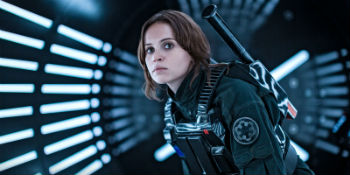 Above all, Rogue One is a war movie, or at least as much of a war movie as you’re going to get with this franchise. The story begins with the execution of a mother (as usual, Star Wars is all about absent parents and bereft children), and concludes with an all-out battle that’s meant to recall World War II Pacific skirmishes, right down to the bright sand, palm trees, and our heroes’ camouflaged uniforms. As long as you have a passing knowledge of Star Wars, the plot is straightforward. Our central protagonist is Jyn Erso (Felicity Jones, making it two-for-two when it comes to pert, winsome British actresses playing leads in the new Star Wars movies), the abandoned daughter of Imperial architect Jalen Erso (Mads Mikkelsen). Jalen has been coerced into building a little something called the Death Star, and when word of the new, horrible weapon gets out (keep in mind this movie takes place just before the events of episode IV), Jyn finds herself pulled into the rebels’ orbit after her father sends her a secret message. Before long she’s thrust into the company of Cassian Andor (Diego Luna), a hardened rebel tasked with tracking down Jalen, and teamed up with a bunch of cast-offs and ne’er-do-wells, including a blind monk who might not be a Jedi but has some bad-ass kung fu skills (Donnie Yen), his gun-toting comrade (Jiang Wen), a twitchy Imperial pilot who has defected to the good guys (Riz Ahmed), and a reprogrammed Imperial droid named K-2SO (a nifty bit of CGI design, voiced by Alan Tudyk) who carries a big punch and a whole lot of attitude. Before you can say “the Dirty Dozen,” our makeshift heroes must take on what looks to be a suicide mission: steal the Death Star plans, which contain information on the station’s critical weakness that will turn the tide of the war in the rebels’ favor (and give Luke Skywalker his big hero moment at the end of episode IV).
Above all, Rogue One is a war movie, or at least as much of a war movie as you’re going to get with this franchise. The story begins with the execution of a mother (as usual, Star Wars is all about absent parents and bereft children), and concludes with an all-out battle that’s meant to recall World War II Pacific skirmishes, right down to the bright sand, palm trees, and our heroes’ camouflaged uniforms. As long as you have a passing knowledge of Star Wars, the plot is straightforward. Our central protagonist is Jyn Erso (Felicity Jones, making it two-for-two when it comes to pert, winsome British actresses playing leads in the new Star Wars movies), the abandoned daughter of Imperial architect Jalen Erso (Mads Mikkelsen). Jalen has been coerced into building a little something called the Death Star, and when word of the new, horrible weapon gets out (keep in mind this movie takes place just before the events of episode IV), Jyn finds herself pulled into the rebels’ orbit after her father sends her a secret message. Before long she’s thrust into the company of Cassian Andor (Diego Luna), a hardened rebel tasked with tracking down Jalen, and teamed up with a bunch of cast-offs and ne’er-do-wells, including a blind monk who might not be a Jedi but has some bad-ass kung fu skills (Donnie Yen), his gun-toting comrade (Jiang Wen), a twitchy Imperial pilot who has defected to the good guys (Riz Ahmed), and a reprogrammed Imperial droid named K-2SO (a nifty bit of CGI design, voiced by Alan Tudyk) who carries a big punch and a whole lot of attitude. Before you can say “the Dirty Dozen,” our makeshift heroes must take on what looks to be a suicide mission: steal the Death Star plans, which contain information on the station’s critical weakness that will turn the tide of the war in the rebels’ favor (and give Luke Skywalker his big hero moment at the end of episode IV).
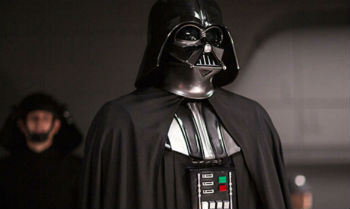 If all of the above sounds a bit like fan fiction, you wouldn’t be far wrong. What used to be the domain of fanboys — mucking about in the nooks and crannies of the storyline, and getting obsessive about vaguely mentioned, unexplored characters and places — is now the stuff of studio franchise strategies, and Rogue One marks the beginning of an expanded cinematic universe, much as we have in the current Marvel movies (no surprise that Disney owns both properties). Such films have a two-fold purpose: Entice new devotees with the lure of a fresh story, while providing enough links to established iconography and characters to keep the old acolytes coming back. And as you would expect of a movie raised in the cradle of a cultural phenomenon, there’s enough callbacks, cameos, and references in Rogue One to keep diehard fans as jolly as pigs in mud. Want to see those classic Imperial destroyers, X-wings, and TIE fighters in action? Want to revisit the rebel base on Yavin’s fourth moon? Want to see some familiar droids, and even a character played by a now-dead actor CGI-ed back to life? Want to hear someone mutter, “I’ve got a bad feeling about this”? Star Wars is fast approaching the James Bond series when it comes to self-referentiality, but while the Bond movies are mostly playful about their formula elements, Rogue One treats them with the reverence of a catechism. Michael Giacchino’s soundtrack only compounds the issue, ladling out overt references to John Williams’ themes and style without arriving at a memorable statement of its own. “Rebellions are built on hope” is a common refrain throughout the movie, which might make for a rousing statement if it wasn’t so obviously cued to remind us that Star Wars Episode IV: A New Hope is just around the corner.
If all of the above sounds a bit like fan fiction, you wouldn’t be far wrong. What used to be the domain of fanboys — mucking about in the nooks and crannies of the storyline, and getting obsessive about vaguely mentioned, unexplored characters and places — is now the stuff of studio franchise strategies, and Rogue One marks the beginning of an expanded cinematic universe, much as we have in the current Marvel movies (no surprise that Disney owns both properties). Such films have a two-fold purpose: Entice new devotees with the lure of a fresh story, while providing enough links to established iconography and characters to keep the old acolytes coming back. And as you would expect of a movie raised in the cradle of a cultural phenomenon, there’s enough callbacks, cameos, and references in Rogue One to keep diehard fans as jolly as pigs in mud. Want to see those classic Imperial destroyers, X-wings, and TIE fighters in action? Want to revisit the rebel base on Yavin’s fourth moon? Want to see some familiar droids, and even a character played by a now-dead actor CGI-ed back to life? Want to hear someone mutter, “I’ve got a bad feeling about this”? Star Wars is fast approaching the James Bond series when it comes to self-referentiality, but while the Bond movies are mostly playful about their formula elements, Rogue One treats them with the reverence of a catechism. Michael Giacchino’s soundtrack only compounds the issue, ladling out overt references to John Williams’ themes and style without arriving at a memorable statement of its own. “Rebellions are built on hope” is a common refrain throughout the movie, which might make for a rousing statement if it wasn’t so obviously cued to remind us that Star Wars Episode IV: A New Hope is just around the corner.
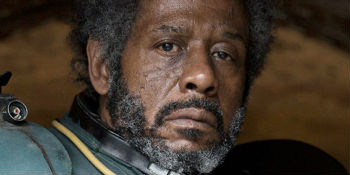 Rogue One is a war movie, all right — a movie at war between the desire to do something new and to connect all the dots to the rest of the saga. Given the onerous task of telling a compelling story while also kowtowing to everything that has come before (and making it all fit together as seamlessly as possible), director Gareth Edwards makes the best of it. Despite some major missteps — those off-putting CGI recreations of old characters, a few brief appearances by Darth Vader that are so over-emphatic that it’s like watching a drag queen strut onto the stage — he paces the action briskly, so that even the fan service goes down without too much fuss. Like J.J. Abrams, who directed Star Wars Episode VII: The Force Awakens, Edwards has a clear affection for the franchise; unlike Abrams, he has a better sense of spectacle and knows how to hold a story together without getting caught up in trying to please audiences every single moment. While the nearly dozen planets represented in Rogue One aren’t as tactile as the ones from the original trilogy — there’s still only so much CGI scenery can do — Edwards has an eye for composition that harkens back to George Lucas’ salad days. Within the parameters of the plot, he also gets to introduce a bit more moral complexity than you’d expect from a Star Wars flick. If the other Star Wars movies are essentially swashbuckling stories about shining knights, Rogue One gets down and dirty with the scum and villainy that make up the backbone of the galaxy. The main baddie this time around, Director Krennic (Ben Mendelsohn) might be an imposing presence, but he’s also a striver within the Imperial hierarchy, forever getting hung out to dry by his superiors. Andor and a few other rebels aren’t above killing off informants or assassinating targets from a distance, as long as the ends justify the means. The Rebel Alliance is riven with arguments between moderates and extremists, with Forest Whitaker’s Saw Gererra the most extreme of them all. Masticating the scenery like there’s no tomorrow, half-machine and half-man, ranting like Marlon Brando’s Colonel Kurtz and sucking on a gas mask like Dennis Hopper’s Frank Booth, Whitaker is completely unhinged, and sorely underused.
Rogue One is a war movie, all right — a movie at war between the desire to do something new and to connect all the dots to the rest of the saga. Given the onerous task of telling a compelling story while also kowtowing to everything that has come before (and making it all fit together as seamlessly as possible), director Gareth Edwards makes the best of it. Despite some major missteps — those off-putting CGI recreations of old characters, a few brief appearances by Darth Vader that are so over-emphatic that it’s like watching a drag queen strut onto the stage — he paces the action briskly, so that even the fan service goes down without too much fuss. Like J.J. Abrams, who directed Star Wars Episode VII: The Force Awakens, Edwards has a clear affection for the franchise; unlike Abrams, he has a better sense of spectacle and knows how to hold a story together without getting caught up in trying to please audiences every single moment. While the nearly dozen planets represented in Rogue One aren’t as tactile as the ones from the original trilogy — there’s still only so much CGI scenery can do — Edwards has an eye for composition that harkens back to George Lucas’ salad days. Within the parameters of the plot, he also gets to introduce a bit more moral complexity than you’d expect from a Star Wars flick. If the other Star Wars movies are essentially swashbuckling stories about shining knights, Rogue One gets down and dirty with the scum and villainy that make up the backbone of the galaxy. The main baddie this time around, Director Krennic (Ben Mendelsohn) might be an imposing presence, but he’s also a striver within the Imperial hierarchy, forever getting hung out to dry by his superiors. Andor and a few other rebels aren’t above killing off informants or assassinating targets from a distance, as long as the ends justify the means. The Rebel Alliance is riven with arguments between moderates and extremists, with Forest Whitaker’s Saw Gererra the most extreme of them all. Masticating the scenery like there’s no tomorrow, half-machine and half-man, ranting like Marlon Brando’s Colonel Kurtz and sucking on a gas mask like Dennis Hopper’s Frank Booth, Whitaker is completely unhinged, and sorely underused.
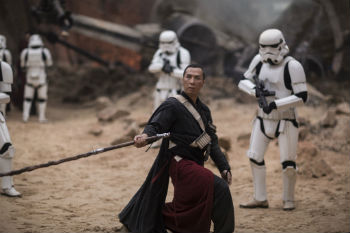 Edwards is efficient at choreographing large-scale mayhem, as you would expect from the man who directed the recent Godzilla remake. Apart from some flashy martial arts work from Donnie Yen, he’s less sure when it comes to close-quarters firefights, but a climactic space brawl puts similar moments in The Force Awakens to shame. While the characters are secondary to all the story and universe-building going on, Edwards draws sympathetic performances from all the principals, and does a decent job at delineating his heroes in shorthand. Still, the film’s busy plot does no favors for actors like Jones, Mikkelsen and Whitaker, who have to channel lifetimes’ worth of betrayals and hurt into the span of a couple rushed sentences. The film doesn’t lack for energy when it comes to presentation and details, but Edwards isn’t as inventive when it comes to plot mechanics. The movie’s climax is more brawny than brainy, especially a clumsy sequence in which our heroes can only prevail if a bulky communication line is connected to a port and a “master switch” is pulled. Classic heroes-on-a-mission movies like The Dirty Dozen may have their weaknesses, but you can always count on them for some hair-raising twists and turns, and the pleasure of seeing a complicated, fleet caper pulled off successfully. Rogue One stresses bombast over wit, and it’s to Edwards’ credit that he pulls off the finale, just barely, even though you can practically smell his sweat as he strains to match the movie’s rushed denouement with the very beginning of Episode IV.
Edwards is efficient at choreographing large-scale mayhem, as you would expect from the man who directed the recent Godzilla remake. Apart from some flashy martial arts work from Donnie Yen, he’s less sure when it comes to close-quarters firefights, but a climactic space brawl puts similar moments in The Force Awakens to shame. While the characters are secondary to all the story and universe-building going on, Edwards draws sympathetic performances from all the principals, and does a decent job at delineating his heroes in shorthand. Still, the film’s busy plot does no favors for actors like Jones, Mikkelsen and Whitaker, who have to channel lifetimes’ worth of betrayals and hurt into the span of a couple rushed sentences. The film doesn’t lack for energy when it comes to presentation and details, but Edwards isn’t as inventive when it comes to plot mechanics. The movie’s climax is more brawny than brainy, especially a clumsy sequence in which our heroes can only prevail if a bulky communication line is connected to a port and a “master switch” is pulled. Classic heroes-on-a-mission movies like The Dirty Dozen may have their weaknesses, but you can always count on them for some hair-raising twists and turns, and the pleasure of seeing a complicated, fleet caper pulled off successfully. Rogue One stresses bombast over wit, and it’s to Edwards’ credit that he pulls off the finale, just barely, even though you can practically smell his sweat as he strains to match the movie’s rushed denouement with the very beginning of Episode IV.
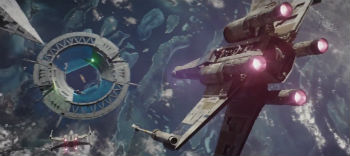 So with Rogue One, we have an odd mix: The film’s most engaging moments come when it strikes out on its own with new characters and environments, but for all the grit and moral complications Edwards touches on, the movie still boils down to a shot of two star destroyers colliding, thousands dying in an instant, while a triumphant fanfare blares forth on the soundtrack. At least Edwards has the conviction to take his more realistic premise to a logical, bittersweet conclusion, and the end of the film shuts the door on inevitable sequels featuring Jyn and company (although one could argue that the sequel already exists). Both subsisting within and yearning to break free from the standard Star Wars rubric, Rogue One can be seen as the faltering few first steps to something different…. but will that something flower, or will it get paved over in future movies in favor of more fan service? Judging by the fact that the next stand-alone Star Wars movie will concern the adventures of young Han Solo, the threat of the latter looms, ever-present.
So with Rogue One, we have an odd mix: The film’s most engaging moments come when it strikes out on its own with new characters and environments, but for all the grit and moral complications Edwards touches on, the movie still boils down to a shot of two star destroyers colliding, thousands dying in an instant, while a triumphant fanfare blares forth on the soundtrack. At least Edwards has the conviction to take his more realistic premise to a logical, bittersweet conclusion, and the end of the film shuts the door on inevitable sequels featuring Jyn and company (although one could argue that the sequel already exists). Both subsisting within and yearning to break free from the standard Star Wars rubric, Rogue One can be seen as the faltering few first steps to something different…. but will that something flower, or will it get paved over in future movies in favor of more fan service? Judging by the fact that the next stand-alone Star Wars movie will concern the adventures of young Han Solo, the threat of the latter looms, ever-present.

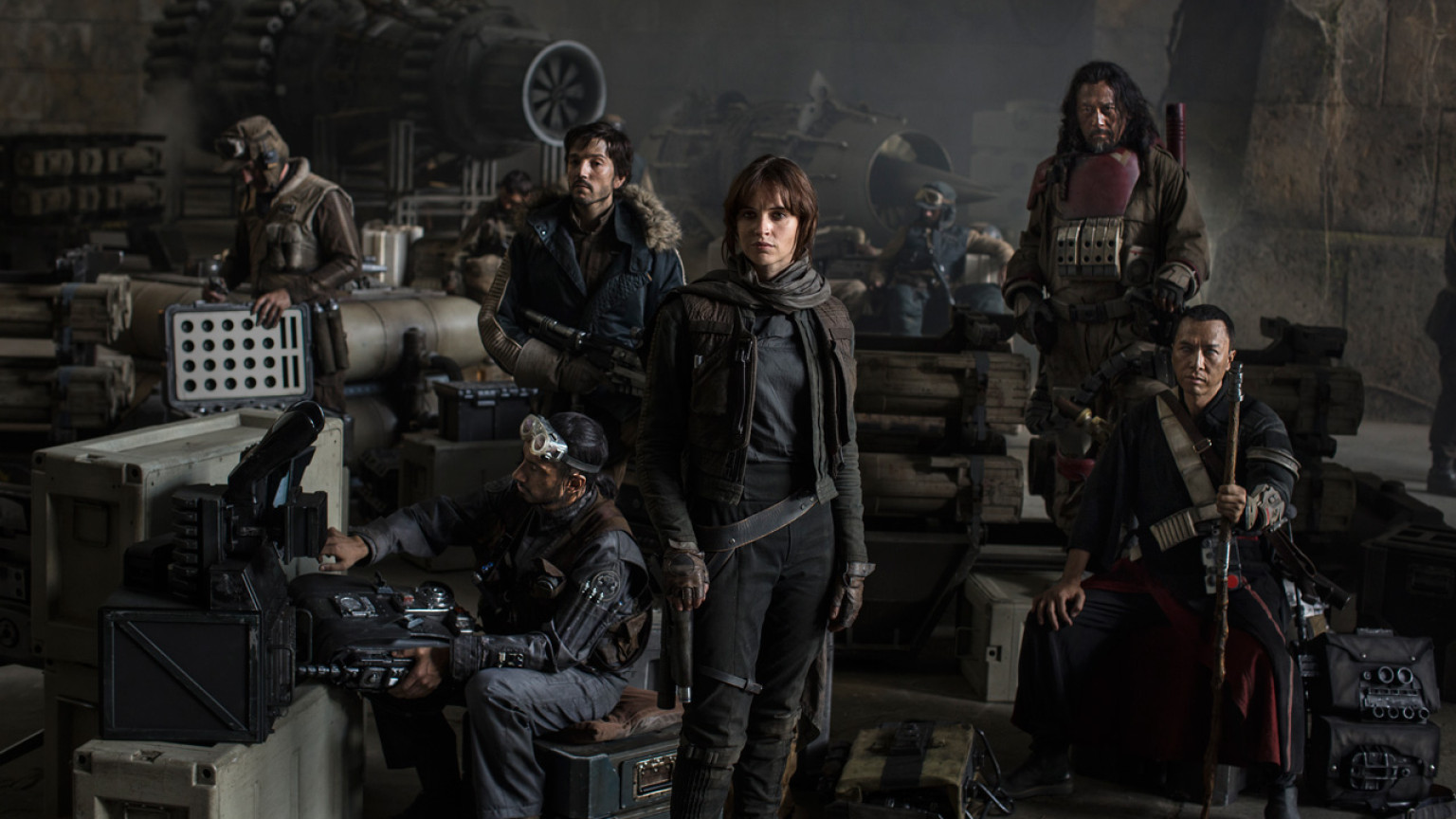
Comments
Jason Lewis
Consider me having Stockholm Syndrome because at this point, I have extraordinarily low expectations for Star Wars films. When a movie like Rogue One comes […] Read MoreConsider me having Stockholm Syndrome because at this point, I have extraordinarily low expectations for Star Wars films. When a movie like Rogue One comes around that is an original-ish story with new characters that dares to explore the universe in a different way, I'm onboard. I really enjoyed it for the most part. I appreciated the energy and the grittiness. The jokes that were thrown in the first half were very much Star Wars humor and it brought back the dark tone of Empire though the darkness is better weighted to the characters and story in Empire. Rogue doesn't have the fun of the fantasy but it does effectively tie into A New Hope well and despite people griping about fan service here, to me, the only truly gratuitous scene was with r2d2 and c3po. The old footage that was spliced in wasn't seamless but it didn't bother me and I appreciate bridging two generations of Star Wars films this way. Rogue One wasn't a delight the way I hoped but it sure hit way more emotional and entertaining notes than The Force Awakens which seems to get more dull and more gratuitously screen tested with each viewing. Read Less